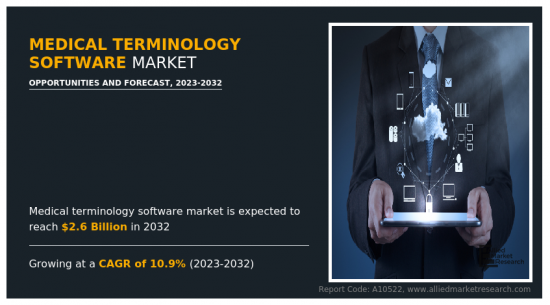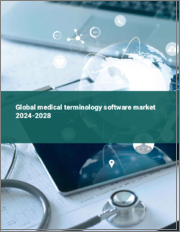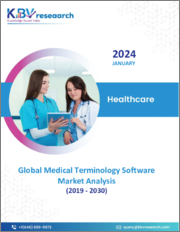
|
시장보고서
상품코드
1344308
의학용어 소프트웨어 시장 : 용도별, 최종사용자별 - 세계 기회 분석 및 산업 예측(2023-2032년)Medical Terminology Software Market By Application (Quality Reporting, Reimbursement, Data Aggregation, Clinical Trials, Others), End User (Healthcare Providers, Healthcare Payers, Others): Global Opportunity Analysis & Industry Forecast, 2023-2032 |
||||||
Allied Market Research가 발행한 최신 보고서 "의학용어 소프트웨어 시장"에 따르면, 의학용어 소프트웨어 시장은 2022년 9억 3,468만 달러로 평가되며, 2023년부터 2032년까지 CAGR 성장률은 10.9%로 2032년에는 26억 달러에 달할 것으로 예상됩니다.
의학용어 소프트웨어는 의료 전문가가 의료 용어, 코드, 약어 등 복잡한 언어를 관리하고 이해할 수 있도록 설계된 전문 도구입니다. 의료 용어, 그 의미, 정의 및 의료 영역에서의 적절한 사용법을 광범위하게 수집한 종합적인 참조 및 데이터베이스 역할을 합니다.

또한, 전 세계 의료 서비스 제공업체들 사이에서 품질 보고 및 규제 준수에 대한 관심이 높아지면서 의학용어 소프트웨어 시장의 성장을 견인하고 있습니다. 예를 들어, 규제 요건을 준수하고 품질 보고를 개선하기 위해 의료 서비스 제공자는 SNOMED CT, LOINC, ICD-10과 같은 표준화된 용어집을 채택하고 있습니다. 의학용어 소프트웨어는 조직이 이러한 용어집을 도입하고 전사적으로 일관되게 사용할 수 있도록 도와줍니다. 또한, 의학용어 소프트웨어는 임상 상황에 따라 적절한 용어와 코드를 제안하는 도구를 임상의에게 제공함으로써 임상 기록의 정확성과 효율성을 향상시킬 수 있습니다. 이를 통해 오류를 줄이고 적절한 코드를 사용하여 양질의 보고를 할 수 있습니다.
목차
제1장 서론
제2장 주요 요약
제3장 시장 개요
- 시장 정의와 범위
- 주요 조사 결과
- 영향요인
- 주요 투자 기회
- Porter's Five Forces 분석
- 시장 역학
- 성장 촉진요인
- 전자건강기록(EHR) 채용 증가
- 임상의사결정지원시스템(CDSS)에 대한 수요 증가
- 품질 보고와 규제 준수에 대한 관심 상승
- 성장 억제요인
- 데이터 프라이버시 문제
- 기회
- 의학용어 소프트웨어로의 인공지능(AI) 통합
- 성장 촉진요인
- COVID-19에 의한 시장에 대한 영향 분석
제4장 의학용어 소프트웨어 시장 : 용도별
- 개요
- 품질 보고
- 진료 보수
- 데이터 집계
- 임상시험
- 기타
제5장 의학용어 소프트웨어 시장 : 최종사용자별
- 개요
- 의료 제공자
- 의료보험 지불자
- 기타
제6장 의학용어 소프트웨어 시장 : 지역별
- 개요
- 북미
- 미국
- 캐나다
- 멕시코
- 유럽
- 독일
- 프랑스
- 영국
- 이탈리아
- 스페인
- 기타 유럽
- 아시아태평양
- 일본
- 중국
- 호주
- 인도
- 한국
- 기타 아시아태평양
- 라틴아메리카
- 라틴아메리카
- 중동 및 아프리카
제7장 경쟁 상황
- 서론
- 주요 성공 전략
- 주요 10개사 제품 매핑
- 경쟁 대시보드
- 경쟁 히트맵
- 주요 기업의 포지셔닝, 2022년
제8장 기업 개요
- Wolters Kluwer N.V
- Intelligent Medical Objects Inc.
- Clinical Architecture, LLC.
- SNOMED International
- Hiveworx
- 3M Company
- West Coast Informatics inc
- TermSolution Gmbh
- BT Clinical Computing
- Rhapsody
According to a new report published by Allied Market Research, titled, "Medical Terminology Software Market," The medical terminology software market was valued at $934.68 million in 2022, and is estimated to reach $2.6 billion by 2032, growing at a CAGR of 10.9% from 2023 to 2032.Medical terminology software is a specialized tool designed to assist healthcare professionals in managing and understanding the complex language of medical terms, codes, and abbreviations. It serves as a comprehensive reference and database that contains an extensive collection of medical terms, their meanings, definitions, and proper usage within the healthcare domain.

Furthermore, the growing focus on quality reporting and regulatory compliance among healthcare providers across the world drives the growth of medical terminology software market. For instance, in order to comply with regulatory requirements and to improve quality reporting, healthcare providers are increasingly adopting standardized terminologies, such as SNOMED CT, LOINC, and ICD-10. Medical terminology software can help organizations implement these terminologies and ensure that they are used consistently across the enterprise. Furthermore, Medical terminology software can help improve the accuracy and efficiency of clinical documentation by providing clinicians with tools that suggest appropriate terms and codes based on the clinical context. This can help reduce errors and ensure that the appropriate codes are used for quality reporting.
In addition, surge in the prevalence of noncommunicable diseases (NCDs) has significantly contributed in the growth of the medical terminology software market. NCDs are chronic diseases that require long-term management and treatment, which involves a lot of documentation and record-keeping. Medical terminology software can help healthcare professionals efficiently document and manage patient information, reducing errors and streamlining the process of data entry. This has become increasingly important as the number of patients with NCDs has grown, creating a greater need for accurate and efficient record-keeping. Nfor instance according to the 2022 factsheet of WHO, each year, 17 million people die from a NCD before age 70; 86% of these premature deaths occur in low- and middle-income countries. However, data privacy issues might restrain the growth of the medical terminology software market. Moreover, the integration of artificial intelligence (AI) into medical terminology software presents various new growth opportunities.
The medical terminology software market is segmented into application, end user and region. By application, the market is categorized into clinical trials data aggregation, reimbursement, quality reporting, and others. On the basis of end user, the market is categorized into healthcare providers, healthcare payers, and others. Region-wise, the market is analyzed across North America (the U.S., Canada, and Mexico), Europe (Germany, France, the UK, Italy, Spain, and rest of Europe), Asia-Pacific (Japan, China, Australia, India, South Korea, and rest of Asia-Pacific), and LAMEA (Brazil, South Africa, Saudi Arabia, and rest of LAMEA).
Key Benefits For Stakeholders
- This report provides a quantitative analysis of the market segments, current trends, estimations, and dynamics of the medical terminology software market analysis from 2022 to 2032 to identify the prevailing medical terminology software market opportunities.
- The market research is offered along with information related to key drivers, restraints, and opportunities.
- Porter's five forces analysis highlights the potency of buyers and suppliers to enable stakeholders make profit-oriented business decisions and strengthen their supplier-buyer network.
- In-depth analysis of the medical terminology software market segmentation assists to determine the prevailing market opportunities.
- Major countries in each region are mapped according to their revenue contribution to the global market.
- Market player positioning facilitates benchmarking and provides a clear understanding of the present position of the market players.
- The report includes the analysis of the regional as well as global medical terminology software market trends, key players, market segments, application areas, and market growth strategies.
Key Market Segments
By Application
- Quality Reporting
- Reimbursement
- Data Aggregation
- Clinical Trials
- Others
By End User
- Healthcare Providers
- Healthcare Payers
- Others
By Region
- North America
- U.S.
- Canada
- Mexico
- Europe
- Germany
- France
- UK
- Italy
- Spain
- Rest of Europe
- Asia-Pacific
- Japan
- China
- Australia
- India
- South Korea
- Rest of Asia-Pacific
- LAMEA
- Latin America
- Middle East Africa
Key Market Players:
- West Coast Informatics inc
- BT Clinical Computing
- Hiveworx
- Rhapsody
- Intelligent Medical Objects Inc.
- TermSolution Gmbh
- SNOMED International
- Clinical Architecture, LLC.
- Wolters Kluwer N.V
- 3M Company
TABLE OF CONTENTS
CHAPTER 1: INTRODUCTION
- 1.1. Report description
- 1.2. Key market segments
- 1.3. Key benefits to the stakeholders
- 1.4. Research Methodology
- 1.4.1. Primary research
- 1.4.2. Secondary research
- 1.4.3. Analyst tools and models
CHAPTER 2: EXECUTIVE SUMMARY
- 2.1. CXO Perspective
CHAPTER 3: MARKET OVERVIEW
- 3.1. Market definition and scope
- 3.2. Key findings
- 3.2.1. Top impacting factors
- 3.2.2. Top investment pockets
- 3.3. Porter's five forces analysis
- 3.3.1. Bargaining power of suppliers
- 3.3.2. Bargaining power of buyers
- 3.3.3. Threat of substitutes
- 3.3.4. Threat of new entrants
- 3.3.5. Intensity of rivalry
- 3.4. Market dynamics
- 3.4.1. Drivers
- 3.4.1.1. Rising adoption of electronic health records (EHRs)
- 3.4.1.2. Increasing demand for clinical decision support systems (CDSS)
- 3.4.1.3. Growing focus on quality reporting and regulatory compliance
- 3.4.1. Drivers
- 3.4.2. Restraints
- 3.4.2.1. Data privacy issue
- 3.4.3. Opportunities
- 3.4.3.1. The integration of artificial intelligence (AI) into Medical Terminology Software
- 3.5. COVID-19 Impact Analysis on the market
CHAPTER 4: MEDICAL TERMINOLOGY SOFTWARE MARKET, BY APPLICATION
- 4.1. Overview
- 4.1.1. Market size and forecast
- 4.2. Quality Reporting
- 4.2.1. Key market trends, growth factors and opportunities
- 4.2.2. Market size and forecast, by region
- 4.2.3. Market share analysis by country
- 4.3. Reimbursement
- 4.3.1. Key market trends, growth factors and opportunities
- 4.3.2. Market size and forecast, by region
- 4.3.3. Market share analysis by country
- 4.4. Data Aggregation
- 4.4.1. Key market trends, growth factors and opportunities
- 4.4.2. Market size and forecast, by region
- 4.4.3. Market share analysis by country
- 4.5. Clinical Trials
- 4.5.1. Key market trends, growth factors and opportunities
- 4.5.2. Market size and forecast, by region
- 4.5.3. Market share analysis by country
- 4.6. Others
- 4.6.1. Key market trends, growth factors and opportunities
- 4.6.2. Market size and forecast, by region
- 4.6.3. Market share analysis by country
CHAPTER 5: MEDICAL TERMINOLOGY SOFTWARE MARKET, BY END USER
- 5.1. Overview
- 5.1.1. Market size and forecast
- 5.2. Healthcare Providers
- 5.2.1. Key market trends, growth factors and opportunities
- 5.2.2. Market size and forecast, by region
- 5.2.3. Market share analysis by country
- 5.3. Healthcare Payers
- 5.3.1. Key market trends, growth factors and opportunities
- 5.3.2. Market size and forecast, by region
- 5.3.3. Market share analysis by country
- 5.4. Others
- 5.4.1. Key market trends, growth factors and opportunities
- 5.4.2. Market size and forecast, by region
- 5.4.3. Market share analysis by country
CHAPTER 6: MEDICAL TERMINOLOGY SOFTWARE MARKET, BY REGION
- 6.1. Overview
- 6.1.1. Market size and forecast By Region
- 6.2. North America
- 6.2.1. Key trends and opportunities
- 6.2.2. Market size and forecast, by Application
- 6.2.3. Market size and forecast, by End User
- 6.2.4. Market size and forecast, by country
- 6.2.4.1. U.S.
- 6.2.4.1.1. Key market trends, growth factors and opportunities
- 6.2.4.1.2. Market size and forecast, by Application
- 6.2.4.1.3. Market size and forecast, by End User
- 6.2.4.2. Canada
- 6.2.4.2.1. Key market trends, growth factors and opportunities
- 6.2.4.2.2. Market size and forecast, by Application
- 6.2.4.2.3. Market size and forecast, by End User
- 6.2.4.3. Mexico
- 6.2.4.3.1. Key market trends, growth factors and opportunities
- 6.2.4.3.2. Market size and forecast, by Application
- 6.2.4.3.3. Market size and forecast, by End User
- 6.3. Europe
- 6.3.1. Key trends and opportunities
- 6.3.2. Market size and forecast, by Application
- 6.3.3. Market size and forecast, by End User
- 6.3.4. Market size and forecast, by country
- 6.3.4.1. Germany
- 6.3.4.1.1. Key market trends, growth factors and opportunities
- 6.3.4.1.2. Market size and forecast, by Application
- 6.3.4.1.3. Market size and forecast, by End User
- 6.3.4.2. France
- 6.3.4.2.1. Key market trends, growth factors and opportunities
- 6.3.4.2.2. Market size and forecast, by Application
- 6.3.4.2.3. Market size and forecast, by End User
- 6.3.4.3. UK
- 6.3.4.3.1. Key market trends, growth factors and opportunities
- 6.3.4.3.2. Market size and forecast, by Application
- 6.3.4.3.3. Market size and forecast, by End User
- 6.3.4.4. Italy
- 6.3.4.4.1. Key market trends, growth factors and opportunities
- 6.3.4.4.2. Market size and forecast, by Application
- 6.3.4.4.3. Market size and forecast, by End User
- 6.3.4.5. Spain
- 6.3.4.5.1. Key market trends, growth factors and opportunities
- 6.3.4.5.2. Market size and forecast, by Application
- 6.3.4.5.3. Market size and forecast, by End User
- 6.3.4.6. Rest of Europe
- 6.3.4.6.1. Key market trends, growth factors and opportunities
- 6.3.4.6.2. Market size and forecast, by Application
- 6.3.4.6.3. Market size and forecast, by End User
- 6.4. Asia-Pacific
- 6.4.1. Key trends and opportunities
- 6.4.2. Market size and forecast, by Application
- 6.4.3. Market size and forecast, by End User
- 6.4.4. Market size and forecast, by country
- 6.4.4.1. Japan
- 6.4.4.1.1. Key market trends, growth factors and opportunities
- 6.4.4.1.2. Market size and forecast, by Application
- 6.4.4.1.3. Market size and forecast, by End User
- 6.4.4.2. China
- 6.4.4.2.1. Key market trends, growth factors and opportunities
- 6.4.4.2.2. Market size and forecast, by Application
- 6.4.4.2.3. Market size and forecast, by End User
- 6.4.4.3. Australia
- 6.4.4.3.1. Key market trends, growth factors and opportunities
- 6.4.4.3.2. Market size and forecast, by Application
- 6.4.4.3.3. Market size and forecast, by End User
- 6.4.4.4. India
- 6.4.4.4.1. Key market trends, growth factors and opportunities
- 6.4.4.4.2. Market size and forecast, by Application
- 6.4.4.4.3. Market size and forecast, by End User
- 6.4.4.5. South Korea
- 6.4.4.5.1. Key market trends, growth factors and opportunities
- 6.4.4.5.2. Market size and forecast, by Application
- 6.4.4.5.3. Market size and forecast, by End User
- 6.4.4.6. Rest of Asia-Pacific
- 6.4.4.6.1. Key market trends, growth factors and opportunities
- 6.4.4.6.2. Market size and forecast, by Application
- 6.4.4.6.3. Market size and forecast, by End User
- 6.5. LAMEA
- 6.5.1. Key trends and opportunities
- 6.5.2. Market size and forecast, by Application
- 6.5.3. Market size and forecast, by End User
- 6.5.4. Market size and forecast, by country
- 6.5.4.1. Latin America
- 6.5.4.1.1. Key market trends, growth factors and opportunities
- 6.5.4.1.2. Market size and forecast, by Application
- 6.5.4.1.3. Market size and forecast, by End User
- 6.5.4.2. Middle East & Africa
- 6.5.4.2.1. Key market trends, growth factors and opportunities
- 6.5.4.2.2. Market size and forecast, by Application
- 6.5.4.2.3. Market size and forecast, by End User
CHAPTER 7: COMPETITIVE LANDSCAPE
- 7.1. Introduction
- 7.2. Top winning strategies
- 7.3. Product Mapping of Top 10 Player
- 7.4. Competitive Dashboard
- 7.5. Competitive Heatmap
- 7.6. Top player positioning, 2022
CHAPTER 8: COMPANY PROFILES
- 8.1. Wolters Kluwer N.V
- 8.1.1. Company overview
- 8.1.2. Key Executives
- 8.1.3. Company snapshot
- 8.1.4. Operating business segments
- 8.1.5. Product portfolio
- 8.1.6. Business performance
- 8.1.7. Key strategic moves and developments
- 8.2. Intelligent Medical Objects Inc.
- 8.2.1. Company overview
- 8.2.2. Key Executives
- 8.2.3. Company snapshot
- 8.2.4. Operating business segments
- 8.2.5. Product portfolio
- 8.3. Clinical Architecture, LLC.
- 8.3.1. Company overview
- 8.3.2. Key Executives
- 8.3.3. Company snapshot
- 8.3.4. Operating business segments
- 8.3.5. Product portfolio
- 8.4. SNOMED International
- 8.4.1. Company overview
- 8.4.2. Key Executives
- 8.4.3. Company snapshot
- 8.4.4. Operating business segments
- 8.4.5. Product portfolio
- 8.4.6. Key strategic moves and developments
- 8.5. Hiveworx
- 8.5.1. Company overview
- 8.5.2. Key Executives
- 8.5.3. Company snapshot
- 8.5.4. Operating business segments
- 8.5.5. Product portfolio
- 8.6. 3M Company
- 8.6.1. Company overview
- 8.6.2. Key Executives
- 8.6.3. Company snapshot
- 8.6.4. Operating business segments
- 8.6.5. Product portfolio
- 8.6.6. Business performance
- 8.6.7. Key strategic moves and developments
- 8.7. West Coast Informatics inc
- 8.7.1. Company overview
- 8.7.2. Key Executives
- 8.7.3. Company snapshot
- 8.7.4. Operating business segments
- 8.7.5. Product portfolio
- 8.8. TermSolution Gmbh
- 8.8.1. Company overview
- 8.8.2. Key Executives
- 8.8.3. Company snapshot
- 8.8.4. Operating business segments
- 8.8.5. Product portfolio
- 8.9. BT Clinical Computing
- 8.9.1. Company overview
- 8.9.2. Key Executives
- 8.9.3. Company snapshot
- 8.9.4. Operating business segments
- 8.9.5. Product portfolio
- 8.10. Rhapsody
- 8.10.1. Company overview
- 8.10.2. Key Executives
- 8.10.3. Company snapshot
- 8.10.4. Operating business segments
- 8.10.5. Product portfolio
- 8.10.6. Key strategic moves and developments



















